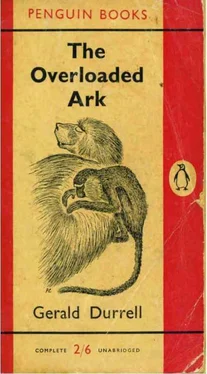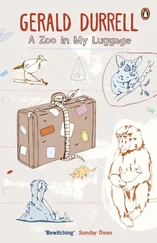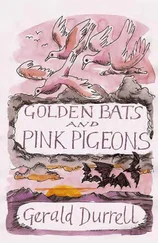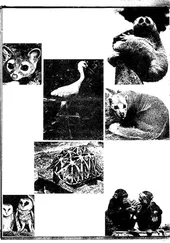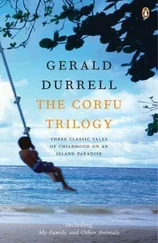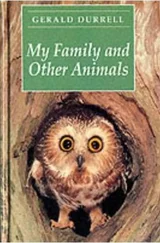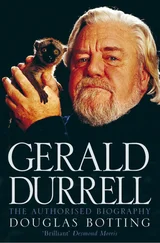I began to wonder what to do. It really needed two people to capture him, but even if I enlisted the aid of Andraia or Elias, there was not room in this narrow tunnel for two people. There was nothing for it but to try and capture him myself. So I carefully wrapped my hand in a canvas bag, laid another bag out on the floor in readiness to put him in, and proceeded to crawl cautiously towards him. He rattled and stamped, and uttered shrill squeaks of warning. I manoeuvred into position and then suddenly grabbed him by his tail, as this seemed the least protected and most easily handled part of his body. I got it, and immediately he backed with full force on to my hand, and his spines ran straight through the canvas that I had wrapped round as protection, as though it was so much paper. It was extremely painful, but I hung on and dragged him towards me, for I felt that if I let go
I might not get another chance to grab him now that he knew my plan of attack. Slowly I wriggled backwards dragging the reluctant porcupine with me, until we were in the small room at the end of the first tunnel. Here there was slightly more room to move, and I tried to get the bag over the animal’s head, but he struggled madly, and backed into my chest, the spines going through my thin shirt and well into my flesh. The confined space was in his favour, for whichever way he turned he managed to dig a spine into the, while I had not room to evade his attentions. The only thing to do was to keep on crawling until I reached the open air. So I wriggled along backwards dragging the porcupine, and those last few feet seemed like miles. Just as we reached the open air he gave a terrific bound and a wriggle in an attempt to throw off my hand, but I hung on like grim death. I got shakily to my feet and kept the animal aloft so he could do no damage to me or himself. He hung there quite quietly; all the fight seemed to have gone out of him.
“Andraia . . . Elias . . . come quick, I done catch beef,” I called.
They came running, their torches bobbing through the rocks. When they saw what I held they were astonished.
“Na Chook-chook beef,” said Elias. “Which side Masa done fine um?”
“Here for dis hole. But he done chop me too much. Get a bag to put him into, my hand done tire.”
Elias opened a big canvas bag and I neatly dropped my capture into it. This was my first meeting with a porcupine, and to have captured it single-handed was, I felt, something of a feat.
The Bush-tailed Porcupine, or, as it is known locally, the chook-chook beef, is one of the commonest animals in the Cameroons: it is found everywhere and in almost every type of country. Most of the faint, twisting paths one found in the forest were the result of the nightly perambulations of this rodent. They would, I found later, make their homes anywhere, but they seemed to favour caves, and particularly caves with small openings under a massive rock, or piles of rocks. In nearly every cave one came across signs of their tenancy: footprints on a sandy floor, a few cast quills, or a half-eaten fruit. In one cave I found fresh palm nuts, which showed that this porcupine in question must have travelled very long distances at night, for the nearest native farm at which he could have obtained this commodity was some six miles away. In another cave I found indications that these porcupines play in much the same way as an English otter will. In this cave there was one wall which was a natural slide, a wall of rock some eight feet high sloping to the ground at a gentle angle of forty-five degrees. This slide had been worn smooth by the constant passage of porcupine bodies or bottoms. Judging by the tracks in the sand, they scrambled up to the top of this slope, slid down, walked round, climbed up again, and slid down once more. They must have been indulging in this game for a number of generations, as the rock-face was worn as smooth as glass. The pidgin-English term for this animal is derived from the word “chook”, which means any thorn or spike, and particularly the doctor’s hypodermic needle. In pidgin you form the plural of a word by repeating it, so the Brush-tailed Porcupine became naturally the chook-chook beef. I decided that this was a good name for the animal, as I was sore and smarting all over from contact with it. Within two days this specimen had become very tame, and would come to the door of his cage to take fruit from my hand. He would only put up his spines, rattle his tail, and stamp his feet if I put my hand right inside the cage and tried to touch him. Later on he would even come to the bars and let me tickle his ears or scratch a soothing spot under his chin, but this was only allowed if there were bars between us.
After I had finished my smoke and had described in boastful details to my hunters how I had captured the porcupine, we continued on our way. Presently I made another capture, and this made me feel better still: true, it was not such an important specimen as the porcupine, but it was worth while, nevertheless. Clasped tightly to a branch, some ten feet from the ground, my wandering torch beam picked out a pair of sleeping chameleons. They were lying close together, their big eyes closed, their legs tucked carefully in, and body-colour a pale and deceiving silvery-green. We had broken the branch and shaken them into a bag almost before they had woken up and realized what was happening. I presumed, since they were sleeping together like that, that they were either in the process of mating or had just mated. It turned out that I was right, for some weeks later the female laid five white eggs the size of a sparrow’s, in the bottom of her cage.
By the time we had bagged the chameleons I was in such an elated mood that I would have hurled myself unhesitatingly into a single-handed battle with a leopard if one had happened along. Luckily, the great cats in the Cameroons are retiring in the extreme. What did make their appearance in the torch beams, shortly afterwards, was a diminutive pair of galagos or bush-babies. There are three species of galago found in the Cameroons, and two of these are rare and have not, to the best of my knowledge, been represented in any zoological collection in England. Accurate identification as to species when an animal is twenty feet above you, and only lit by a torch beam, becomes impossible, so the rule was that any animal remotely resembling a galago was always pursued with determination and vigour. This we proceeded to do with this pair, who were dancing about on some lianas, occasionally looking down at us so that their enormous eyes glowed like outsize rubies. It was definitely a two-man job, so, leaving Andraia to shine the torch on the prey, Elias and I went aloft in different parts of the tree, and started to converge on the animals. They looked not unlike a pair of fluffy grey kittens dancing about from creeper to creeper with a fairy-like grace and lightness, their eyes glowing as they moved. Slowly Elias and I drew nearer, and I manoeuvred the butter-fly net into position for capture. After catching two chameleons and a porcupine, I felt that this was going to be child’s play. Just as I leant forward to swipe at them, three things happened with startling suddenness: my hand I placed on something long and thin and cold which wriggled vigorously, making me let go of the branch with rapidity, at the same time letting go of the net which sailed downwards to the forest floor. The galagos took fright at this and leapt wildly out into space and disappeared. I crouched very still on my branch for I was not certain of the location of the snake I had leant on, nor was I certain of its species.
“Andraia,” I shouted down, “give me some light here. Na snake for dis stick and he go chop me if I no get light.”
Andraia moved round and shone the battery of torches at the place where I clung, and I saw the snake. It was coiled round a bunch of twigs and leaves about a foot from my hand. I surveyed it cautiously: the hind end of its body was tangled and twisted round the twigs, but the forequarters were hung forward in the shape of a letter S, apparently ready for action. It was very slender, with a brown skin and darker markings, and a short blunt head furnished with an enormous pair of eyes. It was about two feet long. I watched it, and it watched me, with approximately the same amount of suspicion. I had nothing with which to capture it, except a small length of string which a frantic search through my pockets disclosed. I fashioned a slip-knot out of this and then broke off a large twig to tie my improvised trap to. At this the snake decided to depart, and proceeded to glide through the branches with a fluid rapidity. Hanging on with one hand and my knees, I made three attempts to get the noose over its slender neck, and with the fourth attempt I succeeded. I drew it tight, and the snake hissed and bunched itself into a knot at the end of the string. I tied my handkerchief round the twig to act as a marker and dropped it down to Andraia with instructions. By the time I had reached the ground he had got it safely into a bag. I was extremely annoyed at the loss of the galagos, for we never saw any more specimens in spite of numerous night hunts.
Читать дальше
